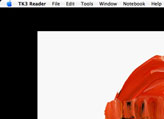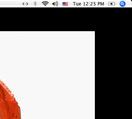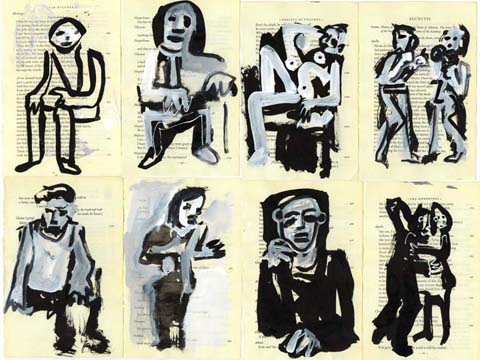last spring we invited Alex Itin to be our first artist-in-residence at the institute. i first met Alex in the fall of 2000, during an art festival in Dumbo. he was set-up in a gallery painting portraits on pages of used books. i quite liked the paintings and got the perverse idea that it would be interesting to encourage someone who was using books in this way to work on an electronic book. i was working at Night Kitchen at the time. we had just released the beta version of TK3, the software we made for authoring and reading media rich electronic books. we lent Alex a Mac and he made his first electronic piece, Zoodoo – a series of paintings done on paperback pages which accompanied a beautiful Amiri Baraka poem. (if you first install the free TK3 Reader you can download Zoodoo from this page.) Alex kept experimenting and over time began animating the surface of his scanned-in paintings. while there has been a long history of filmmakers who painted on the surface of film, Alex was perhaps one of the first painters to integrate video into his paintings.
 |  | |
 |  | |
| From “Self Portait” by Alex Itin | ||
as a condition of his artist-in-residency we asked Alex to keep a blog in which we hoped he would write about his work as he did it. we were amazed after a few days to realize that alex was beginning to use the blog not as a way to talk about his work, but rather it was just another venue for his work. at first Alex posted paintings, drawings and photos sometimes with a text commentary. after a while he started to include animated gifs and sound. although the artist-in-residency ended almost a year ago, alex has been keeping up the blog. in fact, he’s been on a creative tear the past few weeks. check out the last two entries — the “thousand year crane” (be sure to start the music track) and the Chinese new year tree.
(disclaimer: i’ve been collecting Alex’s work for six years now, so my interest in his success is not purely altruistic)


Alex is a successful artist because he is not only a fabulous painter, but because he is extremely prolific and original. I’ve followed his blog as much as possible, but perhaps because I’m a slow art viewer, sometimes the sheer amount of his output becomes too much to handle. I prefer his painting with pigments, and his animations to his commentary. The beauty of his blog is in the images. The Punjabi artist Ranbir Kaleka has been doing extraordinarily complex, and quite monumental, explorations integrating film and painting, but Alex’s blog has subverted the concept of work in progress as a solitary activity. He is making history by generously sharing his creative process with us, using the blog not only as another art venue, but as a venue to view art in a completely different way. The more I think about authentic work that is directly produced and shared online, the less sense the current copyright battles make.
Nam June Paik in 1965: “As collage technique replaced oil paint, the cathode-ray tube will replace the canvas.”
Alex’s digital mashups employ tools that have been around since the earliest days of the web — animated GIFs being the most obvious example — but without the too-easy irony of consciously “retro” net art. What has emerged is a kind of digital primitivism that speaks (to me at least) far more eloquently than the fancy Flash graphics that are in vogue today. The beauty is in the pushing against limits — the limits of paint and the limits of pixels. That’s what comes across in Alex’s blog. Truthful glimpses of that in-between place where we find ourselves today – in between technologies, in between media, in between suffocating nostalgia and ecstatic futurism.
Also: Alex’s work really conveys the feeling of long afternoons wandering through Brooklyn.
thanks all
I love Itin’s work that I’ve seen posted on his blog, particularly “Crosswalk for Shadows and Keys” — partly because of that Brooklyn wandering feeling Ben notes.
Question on your post’s disclaimer Bob–how do you collect art published on the net?
In the case of Itin’s blog, would you consider the blog a collection of discrete works or the blog, as contiguous, the work itself? Is it collectible?
I’m curious what Bob will say, but as for my intention, I think of the blog as one long scroll (Bartleby gone slightly mad). The placement of each post usually follows directly what happened in the previous post- some visual pattern, or pun, or thematic conciet will lead to the next entry. The apt and obvious metaphor is jazz and the improvisational line – each solo is a solo, but relates to some pattern and theme of the whole – only of course I’m soloing to my own solos – oh solo mio.
I had sort of hoped that the blog would become more collaborative (certainly a few friends have dropped by) and the comment section would be more than “Great work” (which is of course nice to hear, but not as interesting as good hard questions like what you’re asking).
There are a lot of raw materials that go into making the blog (drawings, paintings, photos, etc.) all of which I suppose are collectibe. Making “things” and selling “things” was certainly the game I was involved with prior to this electric obssession. The changing distribution of creative content is a problem I’m struggling with every day. The notion of making a painting so that one person can buy that painting and hide it in their house (plus own all copyright to the image) seems fairly bizarre to me these days, but will people by the cow if they get the milk for free? Remains to be seen.
I guess birds like to sing to as many other birds as will listen.